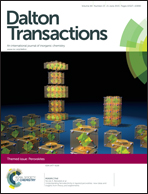Phase transitions and dielectric properties of a hexagonal ABX3 perovskite-type organic–inorganic hybrid compound: [C3H4NS][CdBr3]†
Abstract
A new organic–inorganic hexagonal perovskite-type compound with the formula ABX3, thiazolium tribromocadmate(II) (1), in which thiazolium cations are situated in the space between the one-dimensional chains of face-sharing CdBr6 octahedra, has been successfully synthesized. Systematic characterizations including differential scanning calorimetry measurements, variable-temperature structural analyses, and dielectric measurements reveal that it undergoes two structural phase transitions, at 180 and 146 K. These phase transitions are accompanied by remarkable dielectric relaxation and anisotropy. The thiazolium cations remain orientationally disordered during the two phase transition processes. The origins of the phase transitions at 180 and 146 K are ascribed to the slowing down and reorientation of the molecular motions of the cations, respectively. Moreover, the dielectric relaxation process well described by the Cole–Cole equation and the prominent dielectric anisotropy are also connected with the dynamics of the dipolar thiazolium cations.
![Graphical abstract: Phase transitions and dielectric properties of a hexagonal ABX3 perovskite-type organic–inorganic hybrid compound: [C3H4NS][CdBr3]](/en/Image/Get?imageInfo.ImageType=GA&imageInfo.ImageIdentifier.ManuscriptID=C4DT02875A&imageInfo.ImageIdentifier.Year=2015)
- This article is part of the themed collection: Perovskites

 Please wait while we load your content...
Please wait while we load your content...